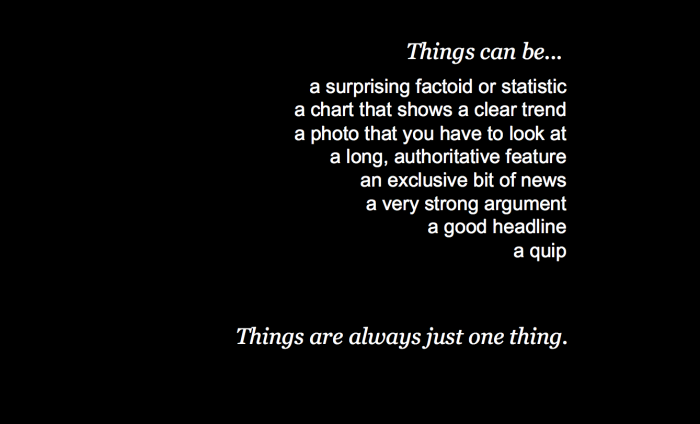“Things are the grist of the social web,” Kevin Delaney, Quartz president and editor-in-chief, noted in a presentation at FIPP’s magazine-focused conference in Toronto Thursday. (Other Quartzies, like Zach Seward, have given similar presentations over the years.) What are “things”? Here’s his slide:

These “things” have been key building blocks of Quartz’s publishing strategy since its launch, in part because they work especially well on social and on mobile. Quartz noted earlier this month that 42 percent of its ad revenue now comes from readers on mobile devices.
Some of Quartz’s most important things are charts. The site published almost 4,000 of them in 2014, and over the summer, Quartz unveiled Atlas, a home and search engine for all of its charts (which users can download and embed). “It was pretty clear people often consider the charts to be their own pieces of content,” Seward, Quartz’s executive editor and VP of product (and a former Nieman Lab staffer) told us at the time.
Charts are key to success for engaging content, says @qz's @kevinjdelaney #FIPPCongress pic.twitter.com/GVhtdaIo5O
— FIPP (@FIPPWorld) October 15, 2015
Meanwhile, Vocativ, a New York-based site that claims to use proprietary technology to mine the deep web for unreported stories, announced Thursday that it’s acquired Dadaviz, an Israeli company that had hoped to be the “YouTube of data visualizations.” The idea behind Quartz’s Atlas and Dadaviz were somewhat similar, but Dadaviz invited users to rank and submit charts from around the web, while Atlas is at least currently limited only to charts created by Quartz.
The acquisition of Dadaviz is part of a bigger push to restructure Vocativ’s content strategy. Since [chief content officer Gregory] Gittrich came on board in January, Vocativ has shifted its strategy to visual storytelling. ‘We’re very focused on creating stories that live in social media now,’ says Gittrich. The idea is that Vocativ’s audience might never actually visit the website, but instead experience Vocativ content through Facebook, Twitter, Instagram, and so on…Vocativ has recognized data viz as every bit as viral as GIFs and videos.
One thing all these types of content have in common: They’re short, and they can be shared easily.
500-800 words is actually a dead zone for mobile readers, says @qz. Go short or go long. #FIPPCongress
— Angie McKaig (@angiemckaig) October 15, 2015
Quartz and Vocativ are by no means the only publishers seeing the value in charts and data viz, obviously. Even President Obama seems to be a fan of the approach. Recently, he asked news organizations to “tally up the number of Americans who’ve been killed through terrorist attacks in the last decade, and the number of Americans who’ve been killed by gun violence, and post those side by side on your news reports.” This was the perfect occasion to, well, make some things.